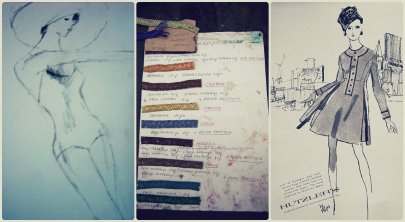Have you designed the next influential thing in fashion? You might want to patent it…
Patents can be used to protect inventions. With wearable technology on the rise, patenting enables inventors to stop third parties from using their invention without permission.
Wearables, like those displayed in the Fashion Bubbles exhibit in New York, are becoming ever increasingly popular, leading to a rise in patent applications!
“Perfect solution” you say? Hold your horses, there are strict requirements on what you can and can’t patent and this post will take you through those hurdles. Also, applying for a patent can be time-consuming and expensive. Doesn’t sound too appealing does it? Well the good news is that the benefits can outweigh the negatives, which this post seeks to explore…
Jump those hurdles
Patents are only available if you have invented a new product or method for doing things. In the fashion industry, this may be a design feature of the garment or a technical feature, such as drag resistance technology, for example.

Patents are a long established form of intellectual property protection…check out this patent plate from 1879 – retro!
One of the earliest examples of patenting in fashion technology is by Danish company Novozymes which revolutionised the traditional use of stones to create stone-washed denim effect by utilising enzymes and microorganisms to create the exact same effect on jeans. Other examples of patenting being used to protect fashion inventions include products such as Speedo’s FASTSKIN FSII swimsuit fabric and Geox’s footwear technology.
The invention itself must be new, inventive and be capable of manufacture, but what does this mean?
- New? There must be no public disclosure prior to putting through a patent application. Fashion tech company XO once deliberately designed wristbands that detect user’s emotions to not work outside the auditorium they were in. This prevented the product from becoming accessible to the public in any way, which would have affected their patent application.
- Inventive? The invention must not be obvious to another person skilled in fashion design.
- Commercialisation? The product should have the ability to be made in any kind of industry.

Gotta be brand new baby!
This means that aesthetic creations, designs or logos, such as the iconic Louis Vuitton symbol, cannot be patented. Instead, a trade mark application could be pursued. For more info on trade marks, see my post on trade marks in the “Hey Hands off my IP!” series here.
Another often over-looked point is that it’s not usually possible to patent software. Software is protected by copyright in the UK. Here’s some more information on copyright from the series.
Sounds great – my invention fits the bill! How do I register a patent?
This is where the fun begins! Unlike copyright, patents need to be registered. Applications have to be made to the Intellectual Property Office (IPO) in the territory or territories in which you want patent protection (usually wherever you are trading) and will require the following details, among others:
- a written description of the invention;
- drawings;
- claims that precisely set out the distinctive technical features of your invention; and
- an abstract that explains all of the important technical aspects of your invention.
Fash tech’s 700m of exquisite light sewn into fabric for the eye’s delight!
Once the application has been processed, the IPO compiles a search report to investigate and assess if the invention is new and inventive, which can take up to 6 months! If all of the formal requirements are met, the application will be published approximately 18 months after filing.
Unfortunately it doesn’t end there…

It’s a long old process, so be prepared to wait!
Within 6 months of publication, more forms will need to be submitted along with an additional fee requesting a substantial examination for any changes required and this is reported back. If all of the application requirements met, the IPO will then grant your patent, publish your final application form and send you a certificate. Hurrah!
How long does a patent last for?
Patents can be granted for up to 20 years, but have to be renewed regularly during the 20 years, incurring a further fee! The first renewal is due 4 years after the date the patent was filed, and then annually. However, as always, there is a price to pay. This ranges from £70 for the first renewal to £600 for the 20th year!!
Wow, that sounds like a lot of effort – why bother with all this hassle?
Although the process to obtain and maintain a patent is long and expensive, with the right product, it is a great tool and can provide many benefits to those looking to generate a long-term investment return.

INTIMACY is a fashion project exploring the relation between intimacy and technology. These Smart fabrics turn transparent when worn in close proximity to another person resulting in feelings of an intimate nature! Yikes!!
In a fast-changing industry such as fashion where trends change season-by-season, it may not always be appropriate to register a patent and another form of IP protection may be better. However, with more and more start-ups looking to combine fashion and wearable technology, patenting could be very beneficial as this industry increasingly becomes mainstream, especially to prospective businesses or investors.
Patenting an invention gives you a monopoly right over your product. The mere existence of a patent application can also deter rival businesses from patenting a similar piece of technology.
Got my patent, now what?
It is your responsibility to police any unauthorised third-party use of the invention where they have manufactured, sold or imported it, not the IPO’s. It may be advisable to set up a watching service so you can keep an eye on any newly filed patent applications within the area of your invention.

Keep a watch out for any potential infringements of your patent – it’s your responsibility, not the IPO’s!
A notable example of patent infringement in the fashion industry was when global retailer H&M infringed the ‘coveted bra technology’ of UK manufacturer Stretchline Holdings in a multi-million pound dispute. H&M sold bras using Fortitube technology without obtaining a licence from Stretchline Holdings. Tut tut!!
This goes to show the importance of having clearance searches carried out before applying to register a patent and also monitoring any future patents – not doing so could lead to a legal nightmare, which no one wants!

3D printing is also on the rise in the fashion industry – yet another form of fash tech!
Top Tips before applying for a patent?
Research, research, research – if the invention is not novel, inventive or capable of being manufactured, then the patent application will fail and your money will be wasted. Research online and through the IPO’s published patents catalogue to ensure there is nothing similar within your industry. This will not only help to ensure your invention is new, but will also ensure you don’t infringe anyone else’s patent rights.
Keep it a secret – confidentiality is crucial if a patent application is being considered. If your invention has been made accessible to the public in any way, this could seriously sabotage your application.

Ssshhh! It’s a secret – don’t spill the beans to avoid having your patent application declared invalid!
Be prepared for commitment – once your invention has been patented, it is important to analyse whether renewals are necessary and to monitor potential developments or inventions within your industry.
For more information on patents, feel free to contact me!


















